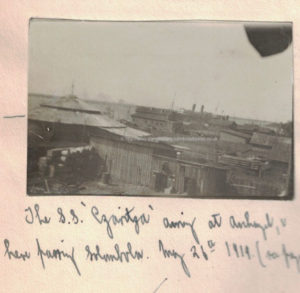26th & 27th May 1919 Monday and Tuesday
Have you any Beer?
All material produced or reproduced here and throughout this work is the sole copyright of the author and the family of Doctor D.C.M. Page MC
“However, the first of the Relief Force did come eventually on Monday, May 26th, 1919. Three huge transports – Czar, Cazarina and Stephen – passed our hospital during the forenoon packed with troops. We all rushed down to the river side which was crowded with Russian civilians. A lot of cheering was indulged in and bands played on board the ships. A lot of back-chat took place between our men and those on board the transports, such as: ‘Have you any beer?’ ‘What is Blighty like?’ etc. It was a great night, and it did us all a lot of good.
That night the Pierrot troupe which Q.M.S. Freeman and I have been training for the last fortnight gave its first performance in the Y.M.C.A. hut at Solombola. The place was packed, and there were many officers present from Archangel. The show went off very well, and we had a tremendous reception. We didn’t finish till 10.30 p.m. owing to having so many encores – a three hours’ show.
The newly-arrived British troops had a triumphal march through the streets of Archangel on the 27th May, and were very enthusiastically received by the Russian population. Flags were flying and great crowds lined the streets. Banners were displayed bearing the words – ‘Welcome to the British’, A Friend in Need is a Friend Indeed’ etc. It seems that no American flags were in evidence, and that the Yanks out here are annoyed at this.”
Whilst wiling away the long hours on the ships as they slowly made their way north and east towards Archangel you may wonder what conversations may have taken place. Let me save you some time in pondering. The young troops whose journey would not have been the hazardous voyage endured by the men they were being sent to relieve would have two pressing concerns. Would there be any beer and what would it be like? Followed by what would the girls be like? On arrival the convoy was met by General Ironside who went by boat to greet them. He was immediately confronted by the yelled question down from those aboard ‘Is there any beer?’ Those ships consisted of three large transports the SS Stephen, the HMTS Czar and also HMTS Tsarina/Czaritza. They had left Woolwich in London between the 11th and 13th May some calling at Newcastle to pick up extra men. Following some delay caused by the ice still in the White Sea they eventually made their way up the Dwina for a much anticipated welcome.
![]()

Image © britishnewspaperarchive.co.uk

This is SS Czar built in Glasgow in 1912

The SS Czar arriving loaded with troops on May 26th 1919
Originally launched on 23rd March 1912, Czar was a passenger/cargo ship of 6503 tons. She was built for the Russian American Line but requisitioned by the Royal Navy before entering service.
During WW1 she was used between New York and Archangel and following the Armistice was decommissioned only to be immediately reinstated for supplying the North Russian Intervention.
During peacetime she underwent changes of name and ownership and served as a transport ship again during WW2. She survived until 1949 before ending her days in Blyth, Northumberland where she was broken up.


The SS Stephen arrives also

The SS Czaritza arriving at Archangel, here passing Solombola, May 26th 1919

Another Glasgow built ship by the Barclay Curle Co. Launched in 1915 and slightly bigger than Czar at 6852 tons the ambiguous names of Czaritza and Tsarina appear to have both been carried during her trips to Archangel. This may account for Douglas’s spelling “Cazarina” or maybe it was just an error by the typist.
Following the Russian Intervention she was sold to the Danish Baltic-American Line and renamed Lituania. Several name changes later found her in the service of the Polish Navy. Evacuation to Dartmouth, England kept her from the clutches of the Nazis during WW2. However, she performed with a great deal of dexterity and valour during that conflict. Many ships acquired the “lucky” tag during times of conflict, surely there can have been few luckier than this. She was attacked on several occasions by the Japanese air force and in 1943 hit by a torpedo that failed to explode.
Surviving until 1950 she was, like her sister ship Czar broken up in Blyth, Northumberland.
Pierrot Troupes was the generic name given to concert parties formed to entertain troops at home and abroad.
Introduced to the British public from a French idea in the 1880s, it had become an immensely popular form of entertainment in the late 19th and early 20th centuries consisting of artists wearing what we might term clowns’ uniforms with pointed or floppy hats and wearing white faced make up. Acts sang, danced, juggled and performed comedy sketches etc.

85th General Hospital Concert Party after a rehearsal

Members of the pierrot troupe interested in the arrival of the relief force.

Douglas the Pierrot
Find out about our connection with Dr Page and an introduction to his diary here